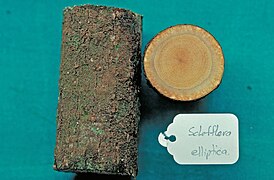|
Heptapleurum ellipticum
Heptapleurum ellipticum, commonly known in Australia as the climbing umbrella tree, is a plant in the family Araliaceae native to the Indian subcontinent, Indochina, Malesia, Papuasia and Australia. DescriptionThe climbing umbrella tree is a vine or scandent shrub growing up to 10 m (33 ft) high and a stem diameter of up to 9 cm (3.5 in).[4][5] The alternately arranged leaves have a petiole measuring 4 to 14 cm (1.6 to 5.5 in) long.[4][5][6] They are compound with 4 to 7 leaflets arranged palmately.[5] Each leaflet measures around 6 to 18 cm (2.4 to 7.1 in) long by 2.5 to 10 cm (0.98 to 3.94 in) wide.[4][5][6] They are leathery and glabrous with usually 5-6 pairs of secondary veins.[6] The inflorescence is about 24 cm (9.4 in) long,[4][6] with flowers arranged in umbels. The globose fruit are very small, about 4–6 mm (0.16–0.24 in) in diameter.[4][6] TaxonomyThis species was first described as Sciodaphyllum ellipticum in 1826 by the Dutch botanist Carl Ludwig Blume, based on material collected near Mount Salak, Indonesia.[7] In 1865 it was transferred to the genus Heptapleurum by Berthold Carl Seemann,[8] then to Schefflera by Hermann Harms in 1894,[9] where it remained for more than a century. In 2020 Porter P. Lowry II and Gregory M. Plunkett published a paper in which they resurrected the genus Heptapleurum and transferred a large number of species − including this one − to it from Schlefflera.[10] Distribution and habitatThe natural range of the climbing umbrella tree is from India through Southeast Asia and Southern China, Melanesia, Papuasia, Christmas Island and northern Australia.[3][4][5] In Australia it is restricted to the northeastern parts of Queensland.[4][11] It grows in mainly in rainforest and gallery forest from near sea level up to 2,500 m (8,200 ft).[4][5][6] UsesThe plant has been used in traditional medicine as a treatment for a number of ailments, including coughs, edema, toothache and wounds.[5] Gallery
References
External links
|
||||||||||||||||||||||||||||||||||||||





